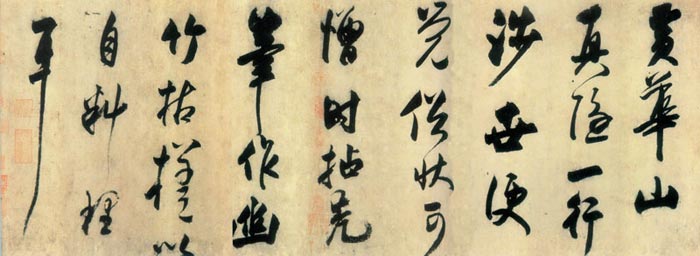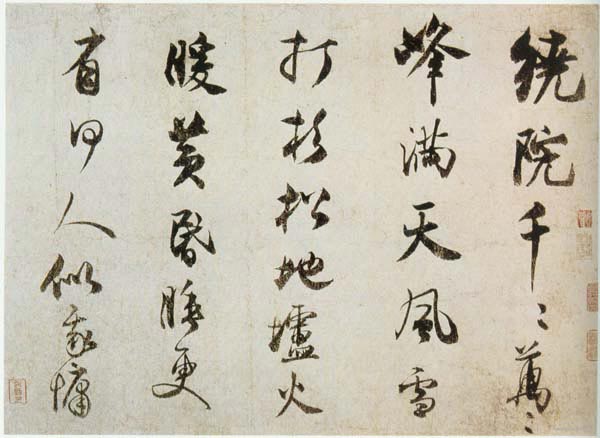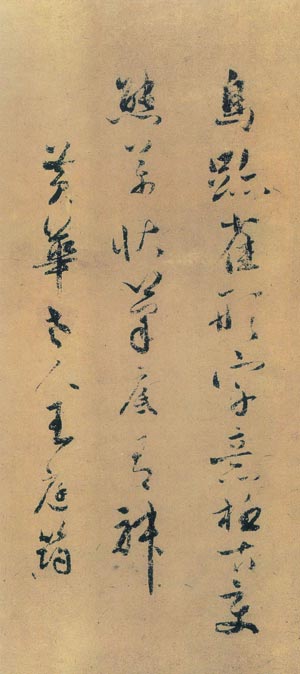Wang Tingyun (1156-1202) was a calligrapher and painter of the Jin Dynasty. His courtesy name is Zidian, his nickname is Huanghua Mountain Master, and he is also known as Huanghua Old Man. Xiong Yue (now Gaiping, Liaoning), grandson of left prime minister Zhang Hao, lived at the foot of Huanghua Mountain in Yuncheng, Shandong. Tingyun was smart since childhood and started learning poetry at the age of 7. Jin Shizong became a Jinshi in the 16th year of Dading (1176), and went to Hanlin to compile it. In the first year of Cheng'an of Jin Zhangzong (1196), he was demoted from his post due to Zhao Bingwen's petition and was demoted to Zhengzhou Defense Judge. Naibu lived in Zhangde, bought a field and studied in Huanghuashan Temple, so he named himself. He recovered in his later years, and in the first year of Taihe (1201), he resumed his official duties and compiled it. He died the next year, and Zhang Zong wrote a poem in memory of him.
Wang Tingyun's "literary and elegant person reflected a moment". He was handsome in appearance, good at talking and laughing, and looked simple and noble on the outside. At first, people did not dare to meet him. Seeing him, his face overflowed with kindness, and he was as diligent and consoling as if he was afraid of not being able to do so. He praised her with rare praise, and he would not hate him even if he suffered a hundred losses in the future. Those who traveled there include Han Wenfu, Lu Yuanheng, Zhang Jinqing, and Li Gongdu, and those who recommended him include Zhao Bingwen, Feng Bi, and Li Chunfu. As Wen Nengdao wanted to say, his poems in his later years had a profound and strict rhythm, and his seven-character long poems were especially rhyming. He is also good at painting, landscape master Ren Xun (alias Junmo), his ink and bamboo are similar to Wen Yuke, his calligraphy and dead wood, bamboo and stone are imitated by Mi Fu, he pays attention to the taste of pen and ink, and is not limited by established methods. He is superior to the ancients, and even misunderstood by future generations. He is "Mi Fu's nephew". Together with Dang Huaiying, Zhao Feng and Zhao Bingwen, he became famous for his calligraphy (see Tang Jie's "Painting Review"). His paintings were closely integrated with poetry and prose, developing the literati painting school and having a great influence on later generations. The paintings handed down from generation to generation include "The Picture of the Withered Bamboo and the Dry Bamboo", written on silk and ink pen. At the end of the volume, Wang Tingyun wrote an inscription in a large running script: "Huanghua Mountain is really hidden. As soon as I experienced the world, I realized that the common appearance was abominable, so I used a bald pen to draw the picture of the withered bamboo." "Cha, you can take care of your ears." The brushwork and ink of this painting are full of changes. The cypress brushwork is lively and hearty, the ink is dripping, and the frost rhymes with iron bones. The bamboo brush is strong and strong, and the leaves are cut like a knife, running in freely. It is now in the collection of Fujii, Kyoto, Japan. It will become a meeting. He is the author of ten volumes of "Collected Works of Wang Hanlin", "Collected Works of Huang Hua" and "Zhen Bian". Zi Wanqing (first written as Manqing), whose courtesy name was Xibo and whose nickname was Danyou, was good at ink painting on bamboo, trees and rocks. He was also able to write poems and calligraphy, and had a fatherly style. He became an official in the provincial government, Yousi Langzhong.

Wang Tingyun, titled "Pictures of Withered Bamboo and Trees", volume on silk, 38.1x117.7cm (full size), ink and pen, Fujii Saisei Collection, Kyoto, Japan
Explanation: Huanghuashan Zhenyin, as soon as he was involved in the world, he felt that the world was abominable, so he used his bald pen to make bamboo branches and withered trees to care for himself.

Wang Tingyun "Li Shan Painting Style Cedar Pine Picture Scroll and Postscript" on paper (painting) 29.7x79.2cm (full size) 31.2x1003.4cm Collection in the United States
Explanation: There are thousands of peaks surrounding the courtyard, and the sky is full of wind and snow, beating down the firs and pines. The hearth is warm and I fall asleep at dusk. Who else can be as sleepy as me?
Mi Fu, a calligrapher, writes quickly and is full of variety. But it is not entirely Mi Fu's style. He has his own characteristics and his writing style is very rigorous. Use the center and side of the pen and make the dots and lines plump and thick, rarely leaving the dry brush white; the pen is elegant and graceful, and the air is super bold. In terms of composition, the beginning and end of the characters in this painting are in white corresponding to each other, and the line spacing is even and appropriate. When handling the lines, pay attention to the coordination and echo, so as to achieve peace and harmony.

Wang Tingyun's "Yanshan Inscription" by Mi Fu








